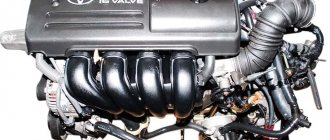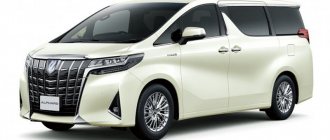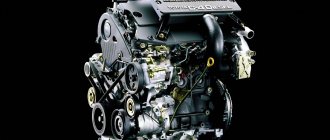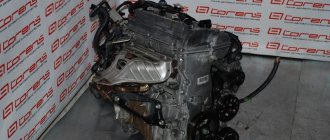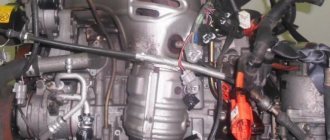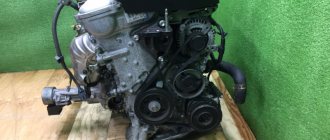The development of Valvematic technology and dual VVT-i became the reason for the release of a new series of engines at Toyota Corporation. New items have found their application in the ZR series of power units, which began its history in 2006. Several motors of the family with different volumes and different applications entered the market at the same time. The 1ZR-FE engine is one of the younger units in the line, which was developed specifically for the C-class.
Characteristics
| Power | 112 - 132 hp (82 - 97 kW) |
| Volume | 1598 cc cm. |
| Design | in-line |
| Fuel type | petrol |
| Fuel mixture | Intake manifold/Carburetor injection |
| Supply system | suction device |
| engine's type | petrol |
| timing belt | DOHC |
| Timing drive | Chain |
| Cooling type | liquid |
| Compression | 10.2 : 1 |
| Piston diameter | 80.5 mm |
| Piston stroke | 78.5 mm |
| Number of cylinders | 4 |
| Number of crankshaft bearings | 5 |
| Number of valves | 16 |
| Torque | 157 Nm |
List of car models in which 1ZR-FE was installed
Russia
- Toyota Auris (08.2012 - 01.2016) hatchback, 2nd generation, E180
- Toyota Auris (07.2010 - 11.2012) restyling, hatchback, 1st generation, E150
- Toyota Auris (10.2006 - 06.2010) hatchback, 1st generation, E150
Europe
- Toyota Auris (10.2006 - 06.2010) hatchback, 1st generation, E150
- Toyota Auris (10.2006 - 06.2010) hatchback, 1st generation, E150
Russia
- Toyota Corolla (03.2016 - present) restyling, sedan, 11th generation, E180
- Toyota Corolla (05.2012 - 07.2016) sedan, 11th generation, E180
- Toyota Corolla (07.2010 - 08.2013) restyling, sedan, 10th generation, E150
- Toyota Corolla (11.2006 - 06.2010) sedan, 10th generation, E150
Europe
- Toyota Corolla (11.2006 - 06.2010) sedan, 10th generation, E150
Design Features
The engine is equipped with a system for adjusting the phases of the intake and exhaust and develops a power of 124 hp. and torque 157 N/m at 5200 rpm.
Suitable for installation of manual or automatic transmission. The engines are installed transversely in the engine compartment, without tilting the block in the direction of the engine shield.
The engine is based on an aluminum cylinder block equipped with thin-walled cast iron liners. The cooling system of the unit has a jacket that is open at the top. The sleeves are poured into the body of the block along the lower edge, the outer surface of the part is rough to improve heat transfer. The sleeves are designed for their entire service life; boring is not provided by the factory. The average engine life is 250-270 thousand km.
The crankshaft axis is shifted laterally relative to the cylinder axes, which improves the operating conditions of the cylinder-piston group. Individual main journal caps are used. A light-alloy upper section of the oil pan is attached to the bottom of the block, closed at the bottom with a steel cover.
The pistons are aluminum, have recesses on the bottom for valves, and a skirt with reduced dimensions. The compression ratio is 10.2, on an engine with a Valvematic system it is increased to 10.7. It is recommended to use gasoline with an octane rating of at least 95 as fuel. The manufacturer's declared fuel consumption in mixed mode is 6.9 liters (for the Corolla sedan).
The 1ZR-FE engine uses a cylinder head with a separate housing for the camshafts. The intake and exhaust valves are arranged in a V-shape at an angle of 29°. The drive uses hydraulic gap compensators, as well as roller tappets equipped with separate oil lines. In the case of Valvematic, a vacuum pump drive is installed on the exhaust camshaft, which is used to operate the brake booster. The timing mechanism is driven by a 1-row chain, with a hydraulic tensioner.
The front cover contains a pump and nozzles that supply oil to the timing chain. The oil pump is equipped with a separate chain drive from the crankshaft. On engines with Valvematic, an original pump with nonlinear pressure regulation is installed. The cooling system is equipped with a pump driven by an attachment belt. A mechanical thermostat is used and a throttle body heating system is installed. Engines with a power of 132 hp. equipped with a separate fan impeller speed control system.
The intake manifold, made of plastic, is located on the front of the block. On the side of the engine shield there is an exhaust manifold made of steel. An exhaust gas neutralizer is installed on the manifold. An additional neutralizer is mounted under the bottom of the vehicle, housed in the same housing as the exhaust noise muffler. The motor complies with Euro-5 environmental requirements.
The intake manifolds of engines with the Valvematic system are equipped with valves that regulate geometry. The use of such a design reduced fuel consumption and improved engine performance. Engine torque increased to 160 N/m at 4400 rpm.
Distributed injection is used to supply fuel. At low temperatures, the nozzles work together or in groups, ensuring stable mixture formation. The throttle unit is equipped with an electronic damper. Electronics are used to operate the vehicle's traction control and stability control systems.
The injectors have extended nozzles that deliver fuel directly to the intake valve area. Because of this, unstable engine operation at subzero temperatures is possible. The fuel supply lines are not equipped with a tube for draining excess gasoline. To regulate the pressure, a special valve installed in the fuel tank is used.
The ignition system includes individual coils. The spark plugs have a reduced diameter, which makes it possible to increase the diameter of the valve plates. The attachment is driven by a poly-V-belt. The tension is adjusted manually by changing the position of the generator.
How does this motor work?
The engine for the Toyota Corolla 1.6 1ZR FE is found in the E160 and E150 body styles, it was developed taking into account previous experience and created using advanced technologies. The gas distribution has a VVTI system, thanks to which the power supply is of the highest quality. In addition, the electronics control the lifting of the valves and the flow of air into the system, which makes the unit operate more efficiently.
1.6 VVT is equipped with two camshafts at once, the valve arrangement is V-shaped. There are hydraulic compensators, so valve adjustment is not required. It is necessary to monitor the quality of the oil; it is advisable to fill it with the original substance. If you do not do this, the hydraulic compensators fail; you can find out about this if there is a knocking sound in the engine.
Advantages and disadvantages
Positive aspects of engines:
- Good power and torque characteristics due to variable valve timing.
- Motor resource.
- Possibility of carrying out major repairs with boring (using non-original parts).
- The prevalence of the unit, the availability of spare parts.
The disadvantages of the motor include:
- Aligning the camshaft drive sprockets with the phase adjustment clutch. The unit is expensive, it is advisable to change it along with the chain.
- The oil system filter is located on the engine shield side, which makes access difficult.
- Possible difficulty starting and missed flashes when the engine is running cold (at low temperatures).
- The tendency of the engine to form carbon deposits in the combustion chambers and on the piston heads.
- Failures of Valvematic system drives and electronic units.
Fuel consumption 1ZRFE
The piston stroke of the 1ZRFE engine was reduced, but the power remained. Which made the motor more reliable. AI95 class gasoline is used as fuel. The manufacturer does not recommend downgrading. Because low-quality fuel will lead to damage to the unit.
Attention! The engine should not be allowed to undergo major overhaul; it is better to do preventive maintenance on time. Since the piston system is not subject to major repairs. Because the internal combustion engine manufacturer made the cylinders thin-walled and reduced the repair dimensions so much that there was no room left for repair maneuvers.
Therefore, 400,000 kilometers is considered the final lifespan of the 1ZRFE engine. The manufacturer and experienced mechanics recommend not saving money on engine maintenance.
Similar article Technical characteristics and reviews of the 2AZ FE engine
In city conditions, a car with a 1ZRFE engine is not maneuverable enough. Fuel consumption per 100 km of almost 6 liters makes itself felt. But when accelerating along the highway, the car is capable of performing any overtaking maneuver.
Car owners of vehicles with a 1ZRFE engine often complain that fuel consumption exceeds the data specified in the technical data sheet. The manufacturer answers this question as follows: “Increased fuel consumption depends on the driving habits of the car owner, rather than on the design of the internal combustion engine.”
Malfunctions and repairs
Main engine problems:
- Ringing when the engine is running under load in the range from 2 to 4 thousand revolutions. When the crankshaft is unscrewed in place, the defect does not appear. If a malfunction occurs, it is necessary to change the head gasket, which burns out between the cylinders.
- Increased oil consumption; the manufacturer considers the norm to be 0.3 liters of fluid per 1000 km. The cause may be waste or oil leakage through leaks between the filter and the crankcase.
- Noise when the timing drive is running, indicating the chain is being pulled out. The problem occurs with a mileage of up to 150 thousand km. Repair consists of replacing drive parts.
- An intermittent whistling sound when the engine is running indicates a worn attachment drive belt. A tightening temporarily solves the problem; it is advisable to replace the belt.
- There are isolated cases of connecting rod breakage and piston contact with valves. A piece of connecting rod breaks through the side wall of the block. Repair consists of purchasing a contract engine or replacing a block and broken parts.
- Pump leaks at seals. The defect begins to appear after a mileage of 60-70 thousand km. After replacing the node the problem disappears.
Service
For normal engine operation, it is recommended to use synthetic oil with a viscosity of 0W-20. If there is increased oil loss not associated with wear of the piston group, it is possible to use thick oils with a viscosity of 0W-30 or 5W-30. According to factory documentation, an oil change is performed every 10 thousand km, but the interval can be reduced to 7-8 thousand km. The oil system capacity is 4.7 liters.
The spark plugs used on engines are equipped with iridium contacts. Replacement is carried out every 100 thousand km. Inspection of the attachment drive belt is performed after 20 thousand km. If defects are found, the part is replaced. Factory antifreeze has a service life of 160 thousand km, subsequent replacements are made every 80 thousand km. The air purification filter is changed after 40 thousand km, the fuel filter - after 80 thousand km.
Tuning
The main way to improve the parameters of the 1ZR engine is to install a Garret 28 turbine. The unit comes complete with an air intercooler, reinforced injectors and pump, oil supply lines, an upgraded intake manifold and an electronic control unit. Additionally, a direct-flow exhaust with a pipe of increased diameter is purchased. It is recommended to install a new piston group and connecting rods to reduce the compression ratio to 8.5-8.8. The engine modified in this way develops up to 350 hp. The downside is the reduced resource.
It is possible to retain the standard piston, but it is necessary to limit the boost pressure to 0.4-0.5 bar. The engine power is up to 180 hp, the service life is slightly less than the atmospheric version. But the most harmless method of improving performance is the use of modified software in the control unit. The power of the power unit increases by 7-10 hp. with a slight improvement in elasticity due to a shift in the torque curve.
Engine Toyota Corolla 1.6 VVT I
The VVT I engine is often found on cars manufactured for the Russian Federation. They have 4 cylinders, an aluminum body, 16 valves, an injection power system and a timing chain. It was possible to improve the characteristics of the unit thanks to the use of VVT-I technology. The valve timing is adjusted almost perfectly, so the engine turned out to be quite dynamic with economical consumption (below 10 liters).
Cars from 2011–2014 received hydraulic compensators, which eliminates the need to adjust the valves. A serious disadvantage of VVT-I is its poor maintainability; the cylinders almost cannot be bored. The characteristics of the engine model are similar to the 1ZR FE.

